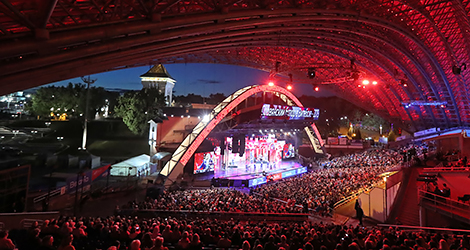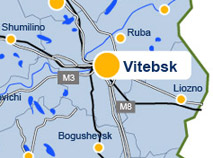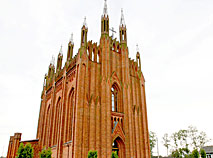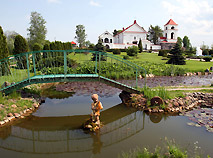Vitebsk region

The Summer Amphitheatre is the main stage of the international art festival Slavonic Bazaar in Vitebsk
The Vitebsk region, one of the six administrative regions (or oblasts) which make up Belarus, is located in the north-east of the country
The Vitebsk region of Belarus borders Russia, Lithuania and Latvia.
The region is known as the Belarusian land of lakes (Belaruskaye Paazerye), and has more than 2800 lakes and 500 rivers. More than a third of the region is forest. Approximately 60% of these forests are centuries-old coniferous woods.
The people of Vitebsk region
-
1.072,1 million people live in the Vitebsk region (on 1 January 2025)
-
72.88% of the population live in the towns and cities
-
85.14% of the population are Belarusians
-
10.15% are ethnic Russian
The main religion is Orthodox Christianity.
Towns and cities in the Vitebsk region
Vitebsk is the main city of the region. There are a further 21 districts, 2 towns have their own regional administrations.
Transport links in the Vitebsk region
The Vitebsk region has borders with three countries and as a result has a very good road infrastructure. Several major international motorways run through the region.
There are more than 1200 km of railway track in the Vitebsk region, with major rail terminals at Vitebsk, Orsha and Polotsk. International railway lines between Russia and Ukraine, Russia and Poland, and Russia and Lithuania all cross the region.
Several rivers including the River Dvina and the River Dnieper run through the Vitebsk region.
There is an airport in Vitebsk.
Industry in the Vitebsk region
The Vitebsk region is one of the major industrial areas of Belarus, with 23% of the workforce employed by industrial companies.
Major industries include:
-
light industries
-
food processing
-
electricity generation
-
petrochemicals
-
mechanical engineering
The main industrial centres are in Vitebsk, Polotsk and Orsha.
There is a free economic zone in Vitebsk.
Natural resources in the Vitebsk region
The Vitebsk region provides a range of natural resources and minerals, including:
-
dolomite
-
clay
-
peat
-
sand
-
mineral waters
Agriculture in the Vitebsk region
The agricultural lands occupy 1.6 million hectares in the region. Animal industries share 55% of agro-industrial manufacturing, and plant growing 45%. Agricultural production also specialises in the manufacture of milk, pork meat, poultry, and cultivation of flax, grain and vegetables.
Fishing is also a significant industry for the Vitebsk region.
Culture and media in the Vitebsk region
The Vitebsk region has a rich cultural heritage. Its many attractions include more than 3 000 archeological, historical, cultural and architectural monuments. There are:
-
2 major theatres
-
a philharmonic society
-
27 museums
There are 25 state newspapers published in the region.
Famous names linked to the Vitebsk region
The Vitebsk region boasts links with a number of internationally famous painters and writers.
Many outstanding people were born and lived in Polotsk. Among them:
-
Euphrosyne Polotskaya – Religious educator
-
Francysk Skaryna – the first Publisher in Belarus
-
Simeon Polotsky – Educator and medieval poet
-
Ivan Hrutsky - Painter
Near Vitebsk, the restored manor of Russian artist Ilya Repin can be found. In the village of Zdravnevo there is also a museum dedicated to the artist.
The well-known researcher of Eastern Siberia, - Ivan Chersky is from the Verhnedvinsk district. The surrounding mountain range is his namesake.
Marc Chagall was born in Vitebsk in 1887, and his home is now a museum.
Kazimir Malevich and Ale Lisitsky worked in Vitebsk.
World famous writers, such as Aleksandr Pushkin, Ivan Lazhechnikov, Ivan Bunin, Vladimir Mayakovsky and Gleb Uspensky also have historical links to the Vitebsk region.







 print version
print version make home page
make home page add to bookmarks
add to bookmarks














